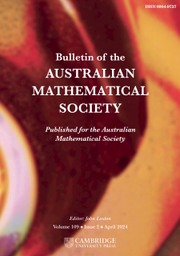Article contents
ON PROBLEMS OF  $\boldsymbol{\mathcal{CF}}$-CONNECTED GRAPHS FOR
$\boldsymbol{\mathcal{CF}}$-CONNECTED GRAPHS FOR  $\boldsymbol{K}_{\boldsymbol{m,n}}$
$\boldsymbol{K}_{\boldsymbol{m,n}}$
Published online by Cambridge University Press: 01 December 2020
Abstract
A connected graph G is  $\mathcal {CF}$-connected if there is a path between every pair of vertices with no crossing on its edges for each optimal drawing of G. We conjecture that a complete bipartite graph
$\mathcal {CF}$-connected if there is a path between every pair of vertices with no crossing on its edges for each optimal drawing of G. We conjecture that a complete bipartite graph  $K_{m,n}$ is
$K_{m,n}$ is  $\mathcal {CF}$-connected if and only if it does not contain a subgraph of
$\mathcal {CF}$-connected if and only if it does not contain a subgraph of  $K_{3,6}$ or
$K_{3,6}$ or  $K_{4,4}$. We establish the validity of this conjecture for all complete bipartite graphs
$K_{4,4}$. We establish the validity of this conjecture for all complete bipartite graphs  $K_{m,n}$ for any
$K_{m,n}$ for any  $m,n$ with
$m,n$ with  $\min \{m,n\}\leq 6$, and conditionally for
$\min \{m,n\}\leq 6$, and conditionally for  $m,n\geq 7$ on the assumption of Zarankiewicz’s conjecture that
$m,n\geq 7$ on the assumption of Zarankiewicz’s conjecture that  $\mathrm {cr}(K_{m,n})=\big \lfloor \frac {m}{2} \big \rfloor \big \lfloor \frac {m-1}{2} \big \rfloor \big \lfloor \frac {n}{2} \big \rfloor \big \lfloor \frac {n-1}{2} \big \rfloor $.
$\mathrm {cr}(K_{m,n})=\big \lfloor \frac {m}{2} \big \rfloor \big \lfloor \frac {m-1}{2} \big \rfloor \big \lfloor \frac {n}{2} \big \rfloor \big \lfloor \frac {n-1}{2} \big \rfloor $.
MSC classification
Information
- Type
- Research Article
- Information
- Bulletin of the Australian Mathematical Society , Volume 104 , Issue 2 , October 2021 , pp. 203 - 210
- Copyright
- © 2020 Australian Mathematical Publishing Association Inc.
References
- 1
- Cited by


